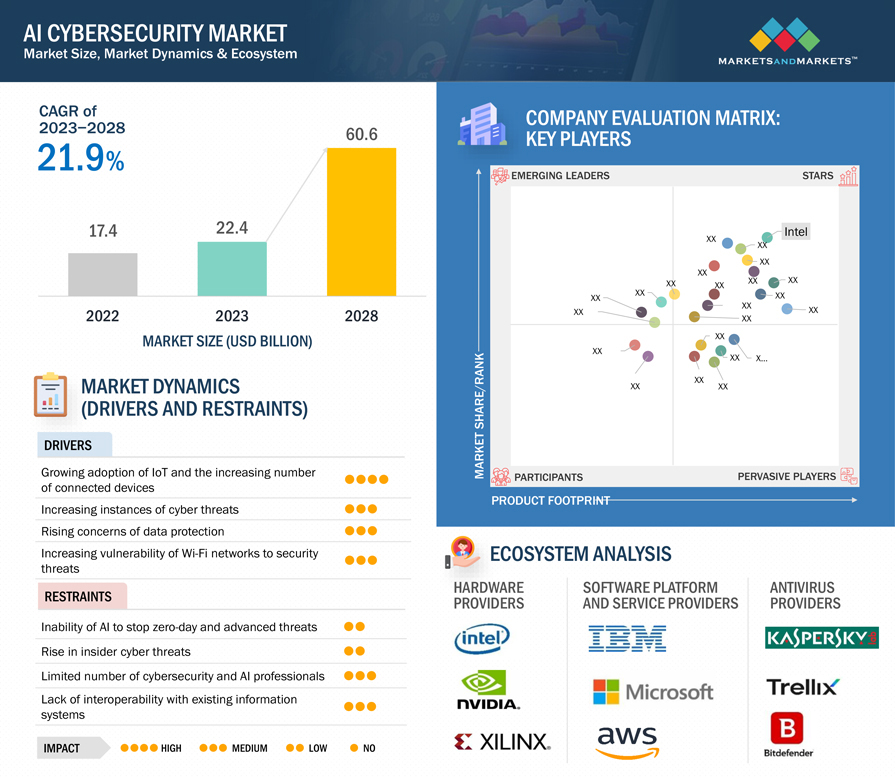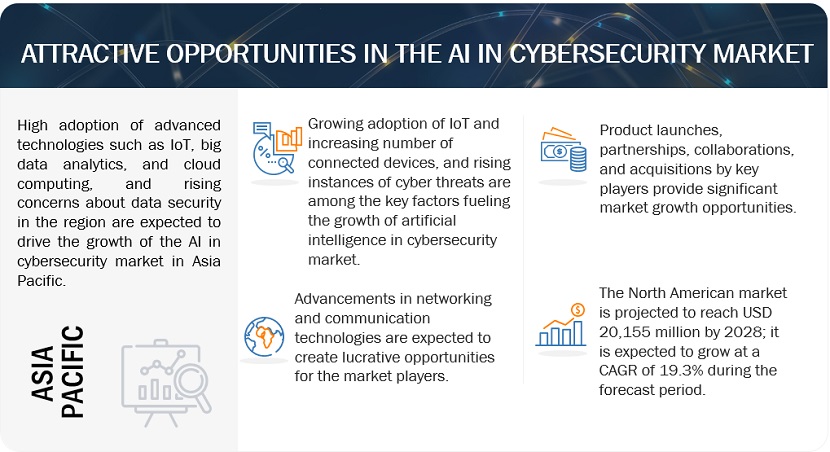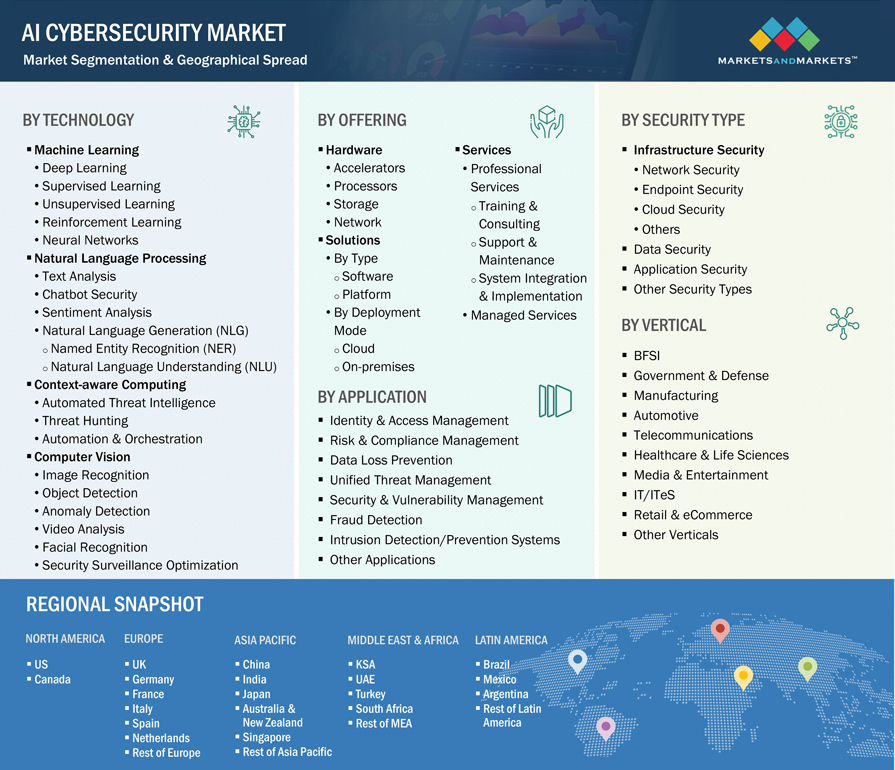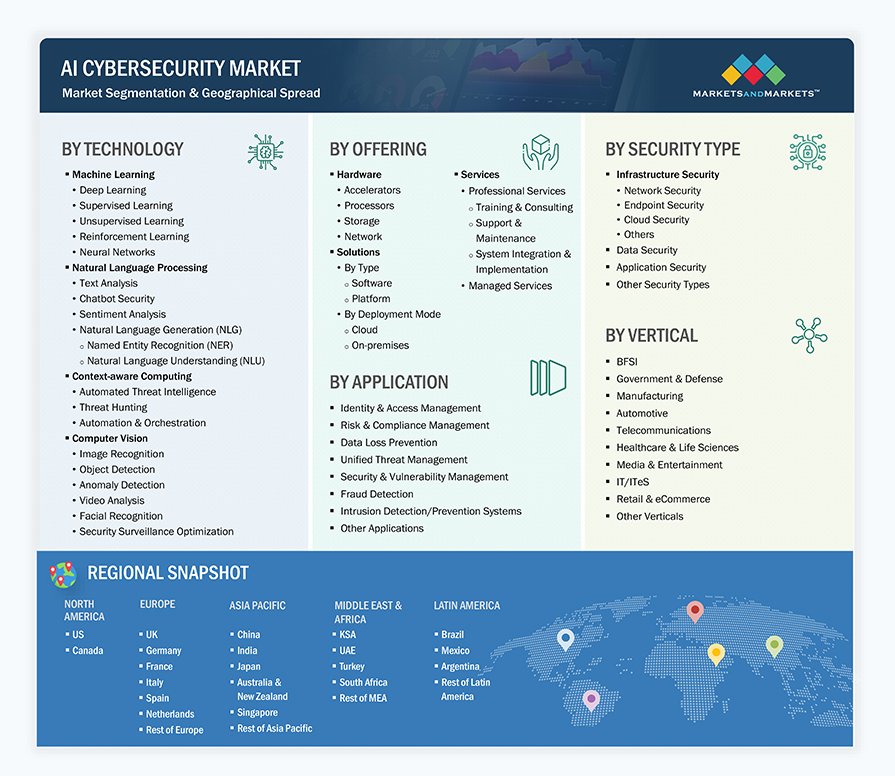※レポートは、MarketsandMarkets社が作成したもので英文表記です。
レポートの閲覧に際してはMarketsandMarkets社のDisclaimerをご確認ください。
The global Al in Cybersecurity Market size was valued at USD 22.4 billion in 2023 and is expected to expand at a CAGR of 21.9% during the forecast period, reaching USD 60.6 billion by 2028. The growing adoption of real-time threat detection solutions within security operations is driving the demand for AI in the cybersecurity market. This trend is crucial for enhancing cybersecurity processes by integrating advanced technologies such as AI, ML, and cloud solutions. Organizations are increasingly recognizing the importance of proactive and swift threat identification and response due to the expanding complexity and prevalence of cyber-attacks. The incorporation of automation trends and smart data utilization in security solutions holds the potential for advanced real-time threat protection. Furthermore, technological advancements are accelerating digital transformation initiatives, aiming to reclaim lost time, reduce customer service costs, and mitigate risks associated with traditional business models. This technological evolution in advanced security solutions is fueling the demand for real-time security solutions, contributing to market growth.
Technology Roadmap of AI in Cybersecurity Market till 2028
The AI in Cybersecurity market report covers the technology roadmap till 2028, with insights into short-term, mid-term, and long-term developments.
Short-term roadmap (2023-2025)
- Utilization of AI for automating routine incident response tasks, reducing response time, and minimizing manual errors.
- Integrating AI-driven threat intelligence platforms with security tools to provide contextual awareness and enrich detection capabilities.
- Integration of explainable AI to enhance transparency and facilitate better understanding of threat detection mechanisms.
Mid-term roadmap (2025-2028)
- Integration of AI, cognitive computing, and automation to create intelligent security systems that can reason, learn, and make decisions autonomously.
- Increased use of federated machine learning models for collaborative threat intelligence.
Long-term roadmap (2029-2030)
- Seamless interaction and collaboration between humans and AI in security operations, leveraging each other's strengths for optimal decision-making and threat response.
- Integration of AI with quantum-resistant encryption to ensure the security of sensitive data.
- Collaboration of AI with blockchain technology to secure data transactions.


AI in Cybersecurity Market Dynamics
Driver: Rise in Cyberattacks Alarming Statistics and Urgent Need for Robust Cybersecurity Measures
Globally, the frequency of cyberattacks is on the rise, impacting individuals, enterprises, and governments, leading to substantial financial losses. Cybercriminals target endpoints, networks, and data, with motives ranging from political rivalry and financial gain to damaging reputation and furthering radical religious group interests. Prominent ransomware such as WannaCry, Petya, NotPetya, and BadRabbit have significantly affected large-scale enterprises and government organizations. The CISCO cybersecurity threat trends report for 2021 reveals alarming statistics, including a high percentage of organizations facing phishing attempts, malicious browser ads, crypto mining, and ransomware-related activities. The escalating sophistication of cyber threats, particularly ransomware, is compelling organizations globally to prioritize cybersecurity solutions and services for safeguarding critical IT infrastructure and sensitive data. According to Microsoft, the US was the primary target of 46% of cyberattacks in 2020, emphasizing the urgent need for robust cybersecurity measures worldwide.
Restraint: Rise in Insider Cyber Threats
Organizational insiders, including employees, vendors, business partners, or maintenance contractors, hold the potential to access company assets physically or remotely, encompassing physical data, electronic devices, and digital assets. The surge in insider attacks poses a growing threat, resulting in data breaches. Insiders, driven by motives like personal gain or selling trade secrets to competitors, target sensitive information, including intellectual property, patents, and copyrights in organizational databases. Healthcare and pharmaceutical sectors face risks such as the theft of patient medical history and IT sabotage due to insider attacks. The shift from outsider to insider attacks is evident across various industries. Despite this trend, AI in security is not commonly employed to detect insider threats, posing a constraint on the market.
Opportunity: Escalating cyberthreat landscape plagues multiple sectors
SMEs, lacking robust security measures, are prime targets for cyber attackers focusing on data, networks, endpoints, and applications. Traditional security systems prove insufficient against threats like WannaCry, NotPetya, ransomware, and malware, necessitating a shift to cloud-based cybersecurity solutions for comprehensive protection across development, production, and implementation phases. Cloud deployment offers SMEs flexibility, scalability, and cost-effectiveness, optimizing business operations. This transition towards cloud solutions creates growth opportunities for providers of cloud-based data protection solutions, such as IBM, HPE, Symantec, McAfee, and Cisco. The adoption of cloud-based security solutions, delivered through Software-as-a-Service (SaaS), addresses the increasing demand for IT security, especially as concerns about cloud data safety rise, further boosting the AI in cybersecurity market.
Challenge: Lack of interoperability with existing information systems
Enterprises, grappling with technological advances like IoT, confront the hurdle of ensuring interoperability with their existing systems. In the realm of cybersecurity, interoperability refers to the capacity of IT systems and endpoint solutions to facilitate seamless data communication and exchange. This capability is essential for the effective delivery of security measures to individuals and businesses. Interoperability challenges arise from integrating devices from different manufacturers, diverse machine batches, and varied operating system support. Numerous associations and organizations are actively addressing this issue. While some existing standards such as MTConnect, EtherCAT, and MDIS facilitate data interchange, the absence of a universal platform for communication across all information security systems remains a significant challenge in addressing current interoperability issues.
AI in Cybersecurity Market Ecosystem

By vertical, BFSI accounts for the largest market size during the forecast period.
The BFSI sector is witnessing substantial AI-driven advancements in cybersecurity. Key areas include AI-enabled fraud detection for real-time prevention, enhanced risk management through data analysis, and the implementation of behavioural biometrics for secure user authentication. Institutions leverage AI-driven threat intelligence for proactive defense against emerging cyber threats and automated incident response, minimizing potential impacts. Compliance management benefits from AI automation, ensuring adherence to evolving cybersecurity regulations. The sector's focus on customer data protection involves employing AI for advanced encryption, anomaly detection, and continuous monitoring. This strategic integration positions BFSI entities to effectively combat evolving cyber threats and regulatory challenges.
Based on the application, data loss prevention holds the highest CAGR during the forecast period.
AI is revolutionizing Data Loss Prevention (DLP) in cybersecurity by employing advanced algorithms for behavioural analysis, anomaly detection, and predictive analysis. These technologies enhance DLP strategies by precisely identifying sensitive data, automating incident responses, and optimizing encryption processes. AI-driven User and Entity Behavior Analytics (UEBA) contribute to the early detection of insider threats and unauthorized access. The integration of artificial intelligence into DLP solutions empowers organizations to proactively safeguard sensitive information, respond swiftly to security incidents, and stay ahead of evolving cyber threats, thereby bolstering overall data protection measures.
By deployment mode, the cloud accounts for the largest market size during the forecast period.
Cloud adoption in AI in cybersecurity is showing, fueled by cost-effectiveness and scalability. Particularly beneficial for SMEs, cloud-based solutions eliminate upfront expenses for hardware, software, and technical staff. The flexibility of cloud platforms allows organizations to scale AI resources as needed, ensuring optimal performance and cost efficiency. This approach streamlines the deployment and management of cybersecurity solutions, with major players such as IBM, Cylance, Microsoft, Amazon, and Darktrace leading in advanced cloud-based services. Overall, the synergy of cloud computing and AI proves instrumental in enhancing cybersecurity measures, providing a unified and agile approach for organizations across different scales.
North America to account for the largest market size during the forecast period.
North America leads in AI cybersecurity due to the proliferation of IoT, 5G, and Wi-Fi 6, with organizations in various sectors fueling 5G expansion. The region prioritizes ML platforms, advanced analytics, and real-time assessment tools to counter potential cyber threats. The adoption of NLP, ML, and neural networks is prominent in detecting and deter attacks, especially in the face of rising mobile device penetration. In Europe, strong government policies and increased cyber cases drive AI cybersecurity growth, exemplified by the UK's Euro 16.5 billion investment in AI and connected hardware. Key European nations are anticipated to intensify investments in cybersecurity solutions, prompting advancements in AI portfolios.

Key Market Players
The AI in Cybersecurity market vendors have implemented various types of organic and inorganic growth strategies, such as partnerships and agreements, new product launches, product upgrades, business expansions, and mergers and acquisitions to strengthen their offerings in the market. The major vendors in the global market for AI in Cybersecurity include NVIDIA (US), Intel (US), Xilinx Inc. (US), Samsung Electronics Co., Ltd (South Korea), Micron Technology, Inc. (US), IBM Corporation (US), Amazon Web Services, Inc. (US), Microsoft (US), Palo Alto Networks Inc. (US), Trellix (US), CrowdStrike (US), NortonLifeLock (US), Cylance Inc. (US), ThreatMetrix Inc. (US), Securonix Inc. (US), Sift Science (US), Acalvio Technologies (US), Darktrace (UK), SparkCognition Inc. (US), Fortinet (US), Check Point Software Technologies, Ltd (US), High-Tech Bridge (Switzerland), Deep Instinct (US), SentinelOne (US), Feedzai (US), Vectra (US) Zimperium (US), Argus Cyber Security (Israel), Nozomi Networks (US), BitSight Technologies (US), and Antivirus companies such as Kaspersky Lab (Russia), Bitdefender (Romania), and ESET (US).
Get online access to the report on the World's First Market Intelligence Cloud
- Easy to Download Historical Data & Forecast Numbers
- Company Analysis Dashboard for high growth potential opportunities
- Research Analyst Access for customization & queries
- Competitor Analysis with Interactive dashboard
- Latest News, Updates & Trend analysis
Get online access to the report on the World's First Market Intelligence Cloud
- Easy to Download Historical Data & Forecast Numbers
- Company Analysis Dashboard for high growth potential opportunities
- Research Analyst Access for customization & queries
- Competitor Analysis with Interactive dashboard
- Latest News, Updates & Trend analysis
Scope of the Report
|
Report Metrics |
Details |
|
Market size value in 2023 |
USD 22.4 billion |
|
Revenue forecast for 2028 |
USD 60.6 billion |
|
Growth Rate |
21.9% CAGR |
|
Market size available for years |
2019–2028 |
|
Base year considered |
2022 |
|
Forecast period |
2023–2028 |
|
Forecast units |
USD Billion |
|
Segments Covered |
Offering, Security Type, Technology, Application, Verticals, and Region |
|
Geographies covered |
North America, Europe, Asia Pacific, Middle East & Africa, and Latin America |
|
Companies covered |
NVIDIA (US), Intel (US), Xilinx Inc. (US), Samsung Electronics Co., Ltd (South Korea), Micron Technology, Inc. (US), IBM Corporation (US), Amazon Web Services, Inc. (US), Microsoft (US), Palo Alto Networks Inc. (US), Trellix (US), CrowdStrike (US), NortonLifeLock (US), Cylance Inc. (US), ThreatMetrix Inc. (US), Securonix Inc. (US), Sift Science (US), Acalvio Technologies (US), Darktrace (UK), SparkCognition Inc. (US), Fortinet (US), Check Point Software Technologies, Ltd (US), High-Tech Bridge (Switzerland), Deep Instinct (US), SentinelOne (US), Feedzai (US), Vectra (US) Zimperium (US) |
This research report categorizes the AI in Cybersecurity Market based on Offering, Security Type, Technology, Application, Verticals, and Region.
By Offering:
-
Hardware
- Accelerators
-
Processors
- Microprocessing Unit (MPU)
- Graphics Processing Unit (GPU)
- Field Programmable Gate Arrays (FPGA)
- Application Specific Integrated Circuit (ASIC)
- Tensor Processing Unit (TPU)
- Other Processors
- Storage
- Network
-
Solution
-
By Type
-
Software
- Standalone
- Integrated
-
Platform
- Application Program Interface (API)
- Machine Learning Framework
-
Software
-
By Deployment
- Cloud
- On-Premises
-
By Type
-
Services
-
Professional Services
- Consulting Services
- Deployment and Integration
- Support and Maintenance
- Managed Services
-
Professional Services
- Solutions
By Security Type:
-
Infrastructure Security
- Network Security
- Endpoint Security
- Cloud Security
- Other Infrastructure Security
- Data Security
- Application Security
- Other Security Types
By Technology:
-
Machine Learning
-
Deep Learning
- Convolutional Neural Networks (CNN)
- Recurrent Neural Networks (RNN)
-
Generative AI
- Generative Adversarial Networks
- Variational Autoencoders
- Transformative AI
- Others
- Supervised Learning
- Unsupervised Learning
- Reinforcement Learning
- Neural Networks
-
Deep Learning
-
Natural Language Processing
- Text Analysis
- Chatbot Security
- Sentiment Analysis
- Natural Language Generation (NLG)
- Named Entity Recognition (NER)
- Natural Language Understanding (NLU)
-
Context-Aware Computing
- Automated Threat Intelligence
- Threat Hunting
-
Automation and Orchestration
- Security Orchestration, Automation, and Response (SOAR)
- Robotic Process Automation (RPA)
-
Computer Vision
- Image Recognition
- Object Detection
- Anomaly Detection
- Video Analysis
- Facial Recognition
- Security Surveillance Optimization
By Application:
- Identity & Access Management
- Risk & Compliance Management
- Data Loss Prevention
- Unified Threat Management
- Security & Vulnerability Management
- Fraud Detection
- Intrusion Detection/Prevention System
- Other Applications
By Vertical:
- Banking, Financial Services, and Insurance (BFSI)
- Retail & eCommerce
- Government & Defense
- Healthcare & Life Sciences
- Telecommunications
- IT/ITeS
- Manufacturing
- Automotive
- Media & Entertainment
- Other Verticals
By Region:
-
North America
- US
- Canada
-
Europe
- UK
- Germany
- France
- Italy
- Spain
- Netherlands
- Rest of Europe
-
Asia Pacific
- China
- Japan
- India
- South Korea
- ANZ
- Singapore
- Rest of Asia Pacific
-
Middle East & Africa
- UAE
- Kingdom of Saudi Arabia
- Qatar
- Turkey
- South Africa
- Rest of the Middle East & Africa
-
Latin America
- Brazil
- Mexico
- Argentina
- Rest of Latin America
Recent Developments:
- NVIDIA and Oracle partnered to enable customers to solve business challenges with accelerated computing and AI. The collaboration aimed to bring the full NVIDIA accelerated computing stack—from GPUs to systems to software—to Oracle Cloud Infrastructure (OCI).
- This partnership would enable organizations, including operators of vital importance (OIV) and operators of essential services (OES), to go further in adopting cloud technology.
- Samsung Electronics Co., Ltd launched LPDDR5X DRAM with a processing speed of 8.5 gigabits per second (Gbps). It delivers low power consumption and high performance by fast processing the data, which is utilized in smartphones, PCs, high-performance computing (HPC), servers, and automobiles. LPDDR5X memory is AEC-Q100* certified, making it the ideal memory solution for high-stress automotive environments.
- NVIDIA IGX is a platform for high-precision edge AI, bringing advanced security and proactive safety to sensitive industries such as manufacturing, logistics, and healthcare.
- Check Point Software Technologies Ltd, collaborated with Intel. Check Point Quantum IoT Protect would be available in Intel Pathfinder for RISC-V*, enabling IoT device developers to integrate cybersecurity easily without impacting product performance.
Frequently Asked Questions (FAQ):
What is AI in Cybersecurity?
Cybersecurity is a set of processes and practices designed to safeguard endpoints, networks, applications, and data from advanced threats and vulnerabilities. Enterprises are required to adopt a set of security technologies, solutions, tools, policies, security concepts, guidelines, risk management approaches, and services to protect critical enterprise information and infrastructure from the growing volume and sophistication of cyberattacks. In such situations, AI in security is used to predict outcomes based on past events. AI software identifies patterns and anomalies pertaining to past events, thereby identifying threats across a firm's network, both on-premises and in the cloud, to mitigate further attacks.
Which countries are considered in the European region?
The report includes an analysis of the UK, Germany, France, Spain, Netherlands and Italy in the European region.
Which are key verticals adopting AI in Cybersecurity?
Key verticals adopting AI in Cybersecurity include BFSI, Retail & eCommerce, media & entertainment, government & defense, healthcare & life sciences, telecommunications, manufacturing, automotive, IT/ITeS, and other verticals (energy and utilities, education, oil & gas).
Which are the key drivers supporting the market growth for AI in Cybersecurity?
The key drivers supporting the market growth for the AI in Cybersecurity market include the Growing adoption of IoT and an increasing number of connected devices, Rising concerns about data protection, and Increasing vulnerability of Wi-Fi networks to security threats.
Who are the key vendors in the market for AI in Cybersecurity?
The key vendors in the global AI in Cybersecuritymarket include NVIDIA (US), Intel (US), Xilinx Inc. (US), Samsung Electronics Co., Ltd (South Korea), Micron Technology, Inc. (US), IBM Corporation (US), Amazon Web Services, Inc. (US), Microsoft (US), Palo Alto Networks Inc. (US), Trellix (US), CrowdStrike (US), NortonLifeLock (US), Cylance Inc. (US), ThreatMetrix Inc. (US), Securonix Inc. (US), Sift Science (US), Acalvio Technologies (US), Darktrace (UK), SparkCognition Inc. (US), Fortinet (US), Check Point Software Technologies, Ltd (US), High-Tech Bridge (Switzerland), Deep Instinct (US), SentinelOne (US), Feedzai (US), Vectra (US) Zimperium (US), Argus Cyber Security (Israel), Nozomi Networks (US), BitSight Technologies (US), and Antivirus companies such as Kaspersky Lab (Russia), Bitdefender (Romania), and ESET (US). .


